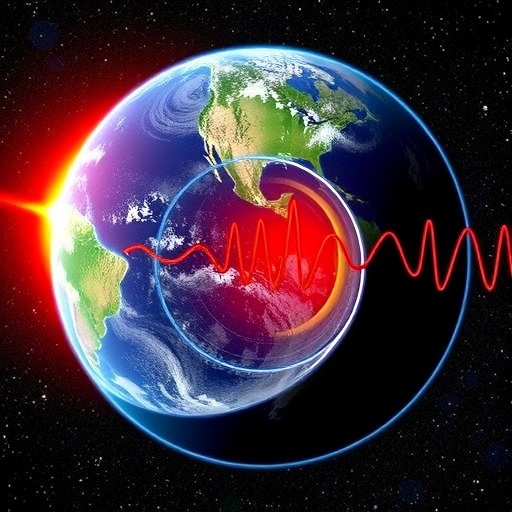Deep beneath the Earth’s surface, at depths nearing 3,000 kilometers, lies a realm that has long fascinated and perplexed geoscientists. Here, within the enigmatic D” layer of the Earth’s lower mantle, solid rock exhibits a strange duality—it behaves neither as a brittle solid nor as a molten liquid. This exotic behavior has recently been demystified by groundbreaking research led by Professor Motohiko Murakami of ETH Zurich. The findings, published in the prestigious journal Communications Earth & Environment, shed new light on the dynamic processes that shape our planet from the inside out.
For more than five decades, the D” layer has posed an enduring puzzle. Located roughly 2,700 kilometers beneath the Earth’s crust, seismic waves traversing this zone undergo abrupt changes in speed—phenomena that suggest a fundamental difference in the material’s properties at these depths. Yet the underlying mechanisms governing this seismic discontinuity remained elusive despite extensive investigation. Early hypotheses centered on mineralogical phase transitions, but they failed to fully capture the observed seismic behaviors.
Professor Murakami’s pivotal work began in 2004 when he identified that the principal mineral of the lower mantle, perovskite, transforms into a novel crystalline structure dubbed "post-perovskite" under extreme pressures and searing temperatures characteristic of the D” layer. This transformative phase change was initially thought to be the key to explaining the seismic anomalies. However, subsequent experimental and modeling efforts revealed that this alone could not account for the rapid increase in seismic wave velocities detected in this region.
In a crucial advance in 2007, Murakami and his team showed that the alignment and orientation of post-perovskite crystals were central to understanding the seismic behavior. Employing sophisticated computer simulations, the researchers demonstrated that only when all the post-perovskite crystals are uniformly aligned does the increased hardness—and consequent acceleration of seismic waves—manifest. This insight fundamentally shifted the scientific perspective: the lattice texture and directional properties of post-perovskite minerals are decisive factors in deep Earth seismology.
The breakthrough came in the form of novel laboratory experiments designed to replicate the extreme conditions native to the D” layer. By subjecting synthetic post-perovskite crystals to intense pressures and temperatures within a controlled environment at ETH Zurich, Murakami and colleagues measured seismic wave speeds directly. Remarkably, these experiments reproduced the sudden seismic velocity jump characteristic of the D” zone, providing incontrovertible proof that mineral texture controls the seismic discontinuity. This milestone represented the final missing piece in the decades-long quest to decode the D” layer.
One of the most profound implications of this research lies in the mechanism behind the uniform crystal alignment. The study identifies mantle convection—a slow, solid-state flow of rock—as the force orchestrating this alignment. Unlike conventional flows of liquid molten rock, the mantle’s solid rock slowly creeps horizontally along the boundary just above the Earth’s core. This flow exerts directional stress that reorients the post-perovskite crystals, effectively knitting the mineral fabric into a coherent pattern that influences seismic wave propagation.
Convincing direct evidence for mantle flow at such astonishing depths has long evaded geophysical observation, making this experimental validation particularly noteworthy. Although mantle convection has been theoretically accepted for years, tangible proof of its presence and effect at the core-mantle boundary was lacking until Murakami’s innovative study. This revelation fundamentally transforms our understanding of Earth’s internal dynamics, confirming that the planet’s deep interior remains in continuous, albeit imperceptibly slow, motion.
The discovery opens exciting avenues for visualizing and mapping the hidden currents within the Earth’s deepest regions. With detailed knowledge of how mantle flow aligns mineral textures and influences seismic signals, geophysicists can refine models of mantle dynamics. This enhanced capacity allows scientists to simulate the forces driving tectonic plate movements, volcanism, and even the generation of Earth’s magnetic field—processes intricately linked to the energy and material transport originating from the core-mantle interface.
Moreover, the recognition that solid rock can flow challenges traditional conceptions of Earth’s interior rigidity. It blurs the boundary between solid and liquid behavior within the mantle, revealing a complex rheology shaped by pressure, temperature, and crystal structure. The post-perovskite phase, by virtue of its unique texture, emerges as a linchpin in mediating these deep Earth phenomena, illustrating how microscopic mineral properties can manifest at planetary scales.
This research not only deepens scientific comprehension but also resonates with broader natural phenomena. Earthquakes, volcanic activity, and tectonic motions—so tangible at the surface—are ultimately powered by the mysterious, slow convective churn of the deep mantle. Murakami’s findings underscore that Earth’s dynamism spans all depths, with invisible forces sculpting the planet’s evolving landscape.
As planetary science advances, this study sets a benchmark for integrating experimental mineral physics with geophysical observations and computational modeling. It exemplifies how meticulous laboratory investigations under high-pressure, high-temperature conditions can illuminate natural processes occurring thousands of kilometers beneath our feet, elevating Earth sciences into new realms of precision and insight.
In sum, the texture-driven alignment of post-perovskite crystals within the D” layer not only elucidates a seismic enigma but also transforms the mantle from a static geological zone into a dynamic, flowing entity. This comprehensive understanding heralds a new chapter in geoscience, enhancing humanity’s ability to visualize and appreciate the powerful, persistent forces that shape our ever-changing planet.
Subject of Research: Not applicable
Article Title: The texture of the post-perovskite phase controls the characteristics of the D” seismic discontinuity
News Publication Date: 23-May-2025
Web References: 10.1038/s43247-025-02383-1
Keywords: Post-perovskite, D” layer, mantle convection, seismic discontinuity, crystal alignment, deep Earth dynamics, core-mantle boundary, mineral physics, high-pressure experiments, seismic wave velocity




